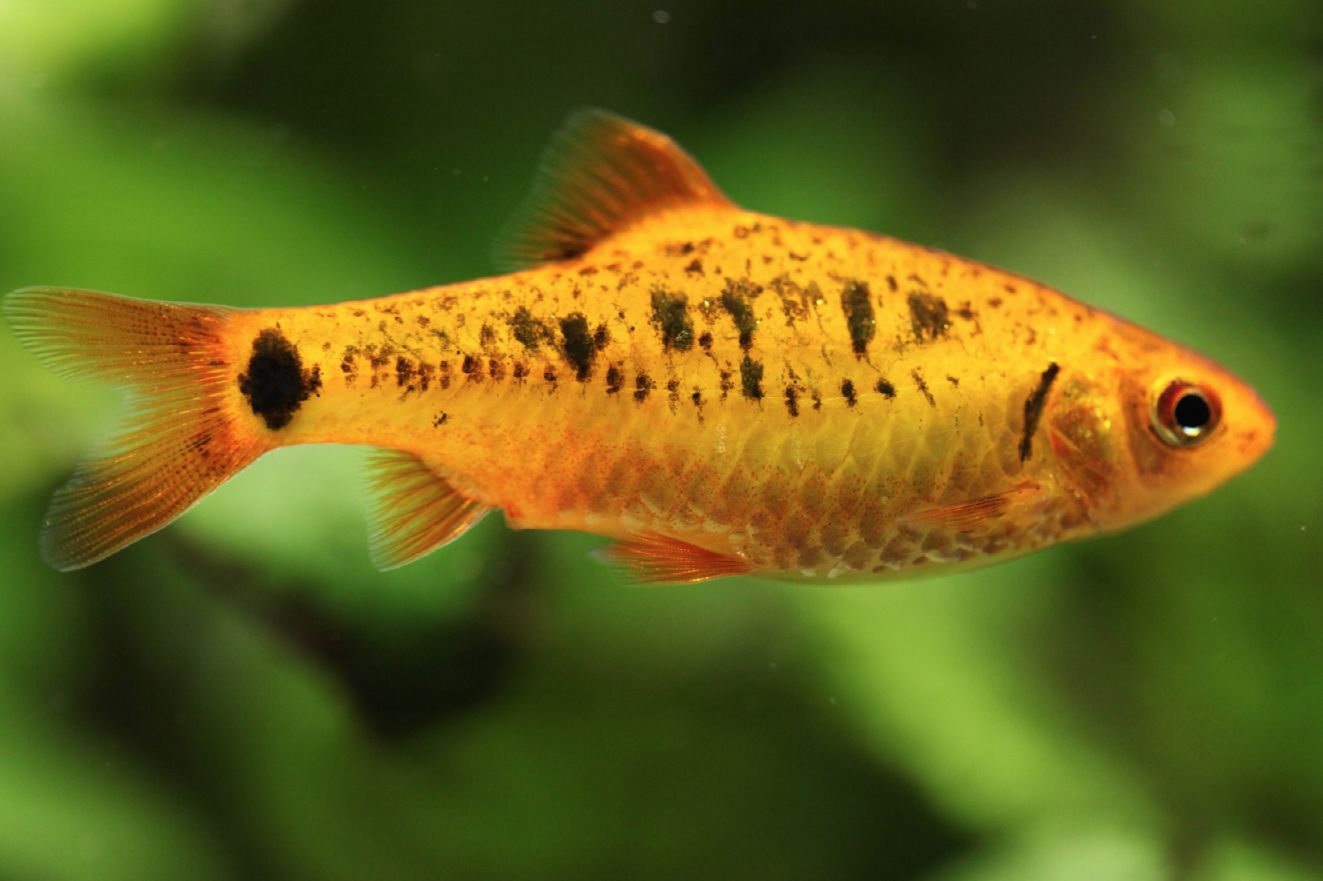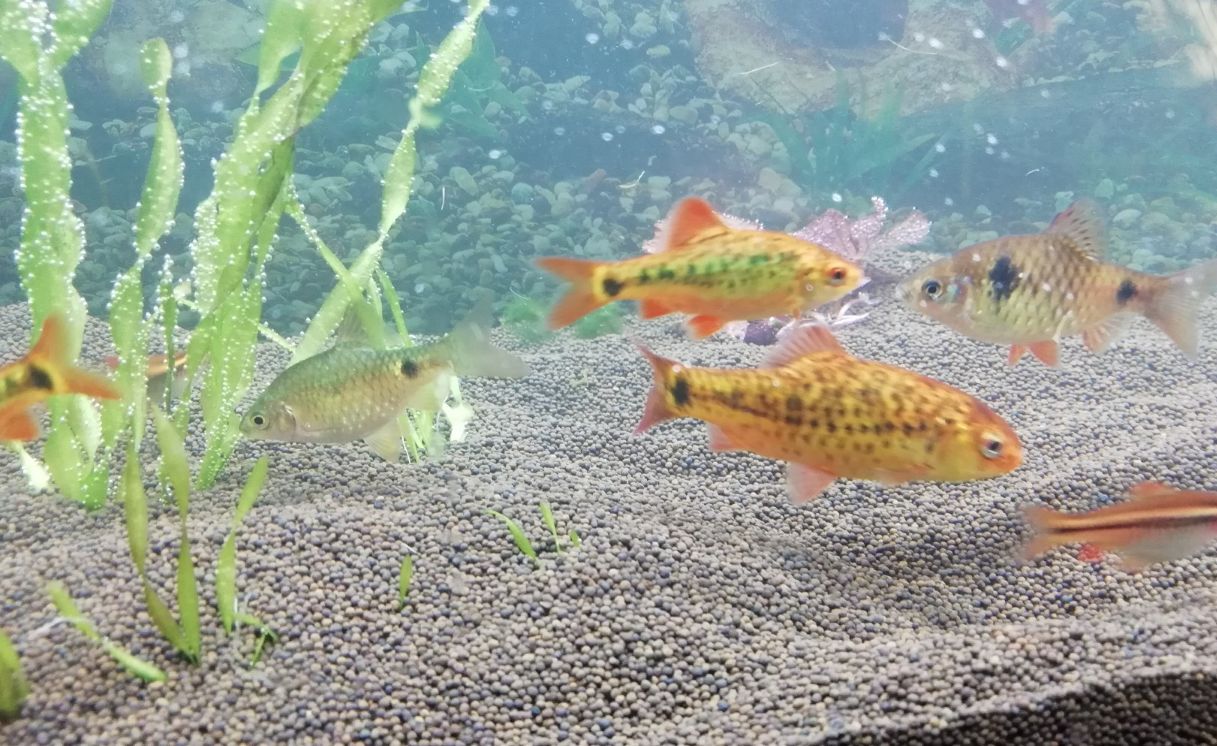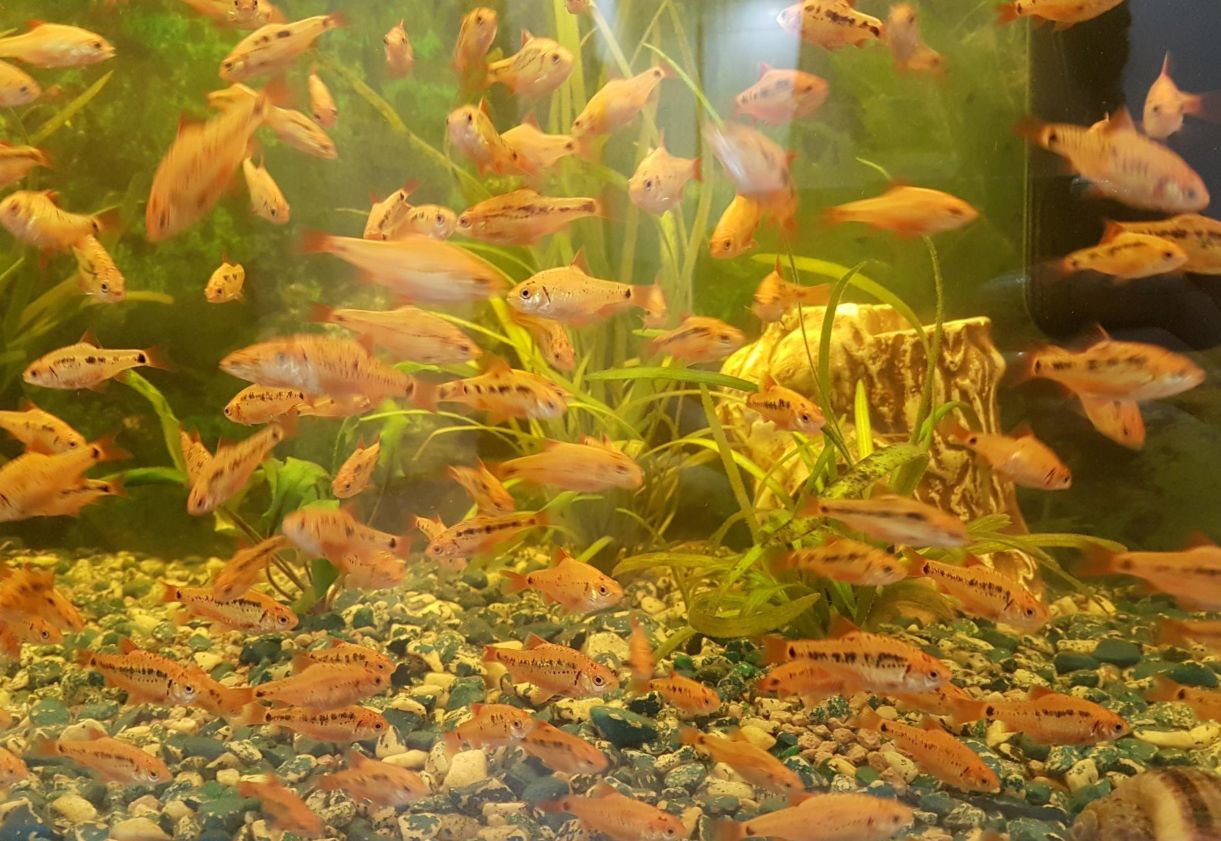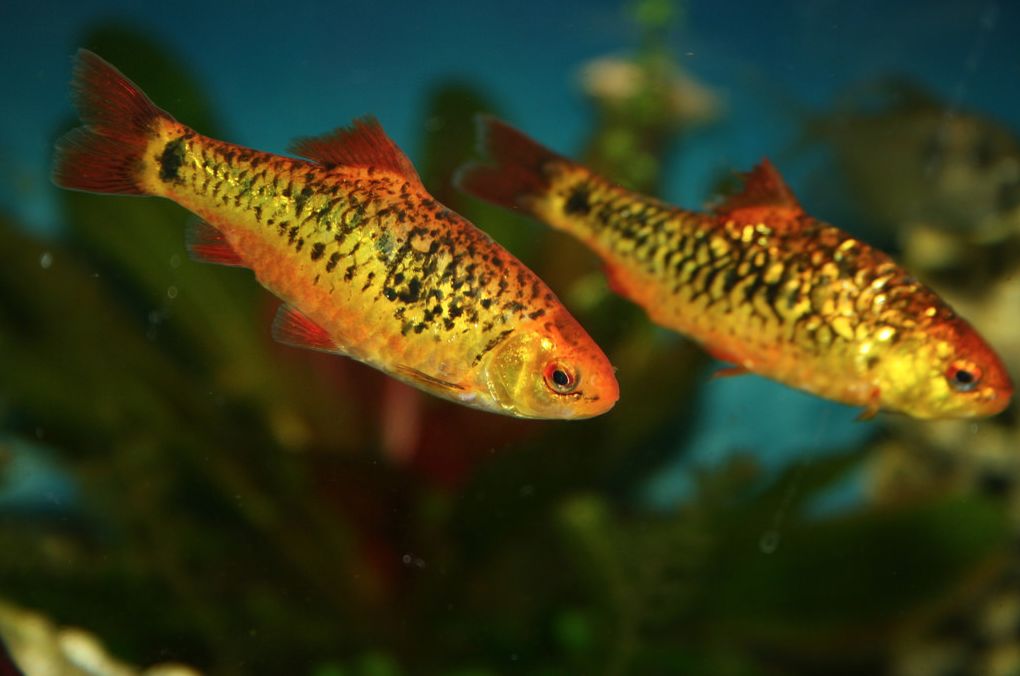Gold barb (Barbodes semifasciolatus var. Schuberti) is a small freshwater aquarium fish from the Cyprinidae family. It has a peaceful temperament and vibrant golden-yellow coloration, making it an attractive addition to community aquariums. Further in the article, you’ll find out how to keep gold barb, feed it, select tank mates, and breed it.

Contents
Habitat in the wild
The gold barb, also known as the chinese barb, is a popular freshwater fish species among aquarium hobbyists. It belongs to the Cyprinidae family, which is the largest family of freshwater fish and includes various species such as minnows, carps, and barbs.
Barbodes semifasciolatus var. Schuberti – var. in the fish name means that it was bred artificially and obtained as a result of long-term line breeding by an American, Thomas Schubert. The fact that wild gold barb populations haven’t been found yet is proof that the fish was bred artificially. One of its names, Schuberti barb, was given by the name of its creator.
As for the fish predecessor, it is widespread in China, Taiwan, Vietnam, and other South-East countries. Due to this fact, the fish has got one more famous name – Chinese barb. Wild Barbus semifasciolatus didn’t have bright coloring, and its scales were gray-green. At the same time, the new bred took a liking to aquarists since its body was shining like gold.
In the wild, gold barb inhabits lentic or slowly flowing waters that get heated in summer up 24 °C. There they find food in upper water layers. They seldom go deeper than 5 meters deep.
An essential part of the natural area includes the subtropical area with more pronounced seasonal temperature fluctuations. Thus, in winter, water temperature in some of its habitats may get low up to 10-15 °C. Therefore, in captivity, this fish kind and its variations may dwell in tanks without heating.
In a mild climate, in summer, they are successfully kept in garden ponds. Keeping the fish in the open air is good for them. Their coloring becomes more intense, and they grow better. Feeding on algae fouling and insects that fall in the water, which the fish eats eagerly, is also beneficial.

Description
This barb has a classical fish body shape. It is moderately flattened from sides and elongated. The back is a bit more curved than the abdomen. There is a pair of short barbs on its mouth sides. These are sensory organs that aid in locating food and navigating their environment. The barbels are not as prominent as in some other barb species.
A distinctive feature of gold barb coloring is a dark-green lateral stripe with black spots scattered along. Such spots are also present on its dorsal and tail fin. The fins are red-orange. The back coloring may vary from yellow-olive to red-cinnamonic. During spawning, its light-colored abdomen becomes orange-red. The body sides shine with a greenish tint, and they are brassy-yellow in the bottom. The tail fin has a classical Y-shape with a large dark spot at the beginning.
How long do golden barbs live?
Golden barbs typically have a lifespan of around 5 to 8 years in captivity. However, it’s important to note that individual lifespan can vary depending on several factors, including the quality of care, genetics, diet, and overall health of the fish.
How big do gold barbs get?
Gold barbs are relatively small fish when fully grown. Adult gold barb may grow up to 7 centimeters (2.8 inches) long, but usually, it doesn’t exceed 5 centimeters (2 inches). Some gold barbs may reach the upper end of the size range, while others may remain slightly smaller.
| Characteristic | Description |
|---|---|
| Scientific Name | Puntius semifasciolatus var. Schuberti |
| Common Names | Gold Barb, Golden Barb, Chinese Barb, Schuberti barb |
| Family | Cyprinidae |
| Origin | East Asia (China, Taiwan) |
| Size | 2-3 inches (5-8 cm) |
| Lifespan | 5-8 years |
| Water Parameters | pH 6.0-7.5, temperature 68°F-79°F (20°C-26°C) |
| Behavior | Peaceful, active, schooling fish |
| Tank Size | 20 gallons (75 liters) or larger |
| Tank Setup | Well-planted with dense vegetation, open swimming space |
| Diet | Omnivorous, accepts flakes, pellets, live and frozen foods |
| Compatibility | Peaceful, suitable for community aquariums |
| Breeding | Separate breeding tank with fine-leaved plants, adhesive eggs |
| Special Considerations | They are active swimmers and appreciate space |
Difficulties in keeping
This is a rather undemanding aquarium fish. If you have experience keeping other barb kinds, you aren’t likely to have any issues with keeping gold barbs.
You should keep gold barbs in a school of at least 5 species, but it better be 10 in a species tank. The fish is rather active, and it likes swimming; therefore, the tank should be elongated. They aren’t very demanding to water quality. However, you shouldn’t neglect filtration and aeration with moderate water flow.

Care and keeping in a tank
Tank size
It is desirable to buy the fish teens about 2,5 cm (1 in) long. If the tank size permits, you should get at least 10 species. This number is usually enough to form a school with an optimal sex ratio. For a group of gold barbs, it is recommended to provide them with a tank size of at least 20 gallons (75 liters) or larger. This tank size allows for adequate swimming space and provides a comfortable environment for a small school of gold barbs.
At that, it’s better to be a long one than wide. The thing is that gold barb is really active and movable; it swims all the time. For this reason, the tank length should be more than its width, while its height doesn’t matter much (25 cm height (10 in) is quite enough).
Having a larger tank is advantageous as it not only accommodates their active nature but also helps maintain water quality more effectively. Additionally, a larger tank provides more opportunities for decorating with plants, rocks, and other aquarium ornaments, which can create a visually appealing and stimulating environment for the fish.
Water parameters
Gold barbs don’t have any special requirements for the hydrochemical water parameters. Here are the recommended water parameters for gold barbs:
- Temperature: Gold barbs prefer a water temperature range of 68°F to 79°F (20°C to 26°C). Keeping the temperature within this range provides them with a suitable and comfortable environment.
- pH Level: Gold barbs thrive in slightly acidic to neutral water conditions. The ideal pH range for them is around 6.0 to 7.5. It’s important to regularly monitor and maintain the pH level within this range to ensure their well-being.
- Water Hardness: Gold barbs can tolerate a moderate range of water hardness. Ideally, the water hardness should be around 5 to 15 dGH (degrees of General Hardness). This range is considered relatively soft to moderately hard water.
- Ammonia, Nitrite, and Nitrate: Gold Barbs are sensitive to ammonia and nitrite, so it’s essential to keep these levels at zero. Regular water testing and proper aquarium maintenance, including regular water changes, are necessary to maintain optimal water quality. Nitrate levels should also be kept low, ideally below 20 ppm (parts per million).
Tank setup: decorations and plants
As for the tank bottom substrate, you should select a dark-colored one. This way, the gold barb will look brighter, and small-sized substrate grains will do for planting live plants. It’s better to put the latter along the tank walls and leave the rest of the space for the fish to swim. Natural stones and snags will make the design look more genuine.
Besides the tank size, it is also important to select proper lighting for it. Gold barb prefer dim light. Also, at half-light, they are less timid and adapt to a new place faster. However, in this kind of lighting, it is difficult to see how good-looking the fish is as well as the choice of plants that you can put in such a tank is quite limited. But bright lighting is also not an option here since the tank walls and plants will be quickly covered with algae, and a metallic appearance will prevail in the fish coloring.
Lamps should be put as close as possible to tank walls. This will allow seeing the gold barb in the reflected light. Besides, if the tank background is dark, barbs will look good on it.
A branchy snag is good as a tank decoration. As for the plants, you should opt for stiff-leaved ones, for example, Cryptocoryne and Anubias. Since long-stalked ones with soft leaves will be nipped by the fish from time to time.
Filtration
Like their predecessors, gold barbs prefer clean water rich in oxygen; therefore, the tank should have a proper filter. Gold barbs benefit from a well-functioning filtration system that helps maintain water quality and provides adequate oxygenation. Aeration, such as the use of an air stone or surface agitation, helps ensure oxygen exchange in the water. Once a week, you should renew the water, about 20% of the tank volume.
Diet
Gold barbs are omnivorous, and they never complain about poor appetite. They eat all types of proper-sized live and artificial food. Feeding gold barbs in a tank is smooth sailing. Due to their omnivorousness, they eagerly eat quality artificial food. I suggest opting for these since live and frozen food is potentially dangerous in terms of infections, and they don’t provide the fish will all the necessary nutrients completely.
Tank mates
Are gold barbs fin nippers? Unlike tiger barbs and rosy barbs, gold barbs don’t nip fins of slow fishes. However, yet I don’t recommend keeping them together with slow fishes with long fins (goldfishes, angelfishes, bettas) since they aren’t predictable and they can behave differently in different tanks. The same is true for gold barb and cherry shrimp. Since the latter are quite small, they may become prey for the fish.
Gold barbs are peaceful, and any not aggressive fishes may be their tank mates. These better be small fishes such as zebra danio, black tetra, boesemani rainbow, cardinal tetra, ember tetra, neon tetra, odessa barb. As for other fish families, small catfishes will do – bristlenose pleco, corydoras julii, panda cory, pygmy cory, hoplo catfish, otocinclus catfish.
Most of the time, they spend in the bottom and middle water layers.

Gender differences: male vs. female
It is almost impossible to define the juveniles’ sex, and adult gold barbs don’t have really visible sex dimorphism. Males are a bit smaller than females, and they have brighter coloring. Reproductive females have noticeably rounded abdomen. Besides, females may not have the black spots we’ve mentioned above, or they may be less visible than that of males.
Once you have enough experience keeping and breeding these fishes, you can easily form couples for spawning and see between males and females.

Breeding
It is easy not only to keep gold barb but also to breed it. They can be recommended to beginning aquarists.
The gold barb becomes reproductive at 10-11 months. The females are the first, and you can see it by the shape of their abdomen. The fish behavior shows if it is ready to breed. First spawning usually happens in a community tank. But in this case, you should forget about getting offspring. Neither eggs nor juveniles don’t have any chance to survive there. Sooner or later, they’ll be eaten either by barbs or their tank mates.
For successful gold barb breeding, it is enough to put one couple or a group of fish in a separate tank. There is nothing difficult in preparing such a tank. Often there is no need to prepare the water. You just need to find a tank of sufficient capacity at a rate of 30 liters for a fish couple sized 5 cm (2 in) each.
Optimal spawning tank shape is when its width is larger than its height. Other variants are possible. You should put a separating net on the s[awning tank bottom and a bush of small-leaved plants. At that, the water level above the net should be not less than 10 cm (4 in). This is to make sure that most of the eggs get under the net before it is eaten.
Breeders are kept separately for 7-10 days before spawning. The diet during this time should contain only live food. Standard spawning tank environment for barbs and preliminary preparation of the breeders will almost for sure lead to spawning even at relatively low water temperature 24 °C.
You can put the males to the volume, which is supposed to be a spawning tank. Once the time is right, better in the evening, out the female to the tank with a male and slowly increase the water temperature to 26 °C. If the breeders were prepared well, the spawning would start soon.
Male’s coloring becomes noticeably brighter. He starts swimming in circles around the female. The spawning occurs near the tank plant’s bottom.
During spawning, an adult gold barb female can lay up to 200 transparent eggs smaller than 1 mm in diameter. Water temperature in the spawning tank is maintained within 24-26 °C, and hydrochemical water parameters don’t play an important role.
Once the spawning is over, the breeders are removed from the tank, and weak aeration should be turned on. Since the fish produces many reproductive products into the water, especially in the case of group spawning, once it is over, it is recommended to renew 20-30% of the water with a fresh one with the same parameters and temperature.
Eggs incubation, depending on the temperature, usually lasts no longer than two days. After that, small semi-transparent larvae hatch from the eggs. If you take a closer look, you can see that they hang almost still on the tank walls and plants and only sometimes move from one place to another.
This way they spend two more days. Once their yolk sac is over, completely formed juveniles start to swim, looking for food. From this moment, you should start to feed them. For this reason, infusorians should always be present in a tank with juveniles. You can use artificial food for juveniles as well.
Now you can remove the separating net and plants that served as spawning substrates. You can put several apple snails to keep the tank with juveniles clean.
The gold barb juveniles grow quite fast. Provided with standard tank conditions that include diversified diet, timely transfer to a larger tank, and regular water renewals as well as keeping the tank clean almost all barb juveniles grow successfully.